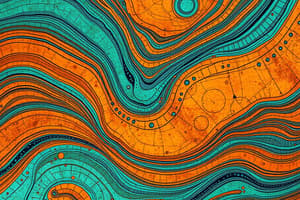Podcast
Questions and Answers
What characteristic of copper helps it resist further corrosion when exposed to air and salt water?
What characteristic of copper helps it resist further corrosion when exposed to air and salt water?
- Ductility
- High malleability
- Formation of a protective patina (correct)
- Excellent electrical conductivity
Which of the following is a use of lead?
Which of the following is a use of lead?
- Piping for water supply
- Electrical wiring
- Roofing materials
- Solder and radiation shielding (correct)
Which of the following statements is true about brass?
Which of the following statements is true about brass?
- It is used primarily for electrical wiring.
- It is an alloy of copper and lead.
- It consists primarily of copper and zinc. (correct)
- It is a type of bronze.
What is the main composition of statuary bronze?
What is the main composition of statuary bronze?
Which bronze alloy contains 3% silicon?
Which bronze alloy contains 3% silicon?
What is the primary use of common brass?
What is the primary use of common brass?
Which type of brass contains aluminum as a primary component?
Which type of brass contains aluminum as a primary component?
What percentage of copper is found in Muntz Metal?
What percentage of copper is found in Muntz Metal?
Which bronze alloy is known for its high corrosion resistance?
Which bronze alloy is known for its high corrosion resistance?
What is the primary difference between Naval Brass and common brass?
What is the primary difference between Naval Brass and common brass?
What is the primary use of aluminum foil?
What is the primary use of aluminum foil?
Which type of aluminum is specifically designed for increased strength through heat treatment?
Which type of aluminum is specifically designed for increased strength through heat treatment?
What characteristic differentiates corrugated aluminum from other types of aluminum?
What characteristic differentiates corrugated aluminum from other types of aluminum?
What is the main purpose of aluminum cladding in products like Alclad?
What is the main purpose of aluminum cladding in products like Alclad?
How is aluminum typically shaped during the extrusion process?
How is aluminum typically shaped during the extrusion process?
Which type of aluminum is typically used for applications requiring high strength and light weight?
Which type of aluminum is typically used for applications requiring high strength and light weight?
What type of flashing is typically used at eaves to prevent water ingress?
What type of flashing is typically used at eaves to prevent water ingress?
Which type of aluminum alloy gains strength through cold working?
Which type of aluminum alloy gains strength through cold working?
Aluminum sheet and strip are typically utilized for which of the following applications?
Aluminum sheet and strip are typically utilized for which of the following applications?
What is the common thickness of aluminum foil mentioned?
What is the common thickness of aluminum foil mentioned?
What advantage does steel's higher modulus of elasticity provide over aluminum in structural applications?
What advantage does steel's higher modulus of elasticity provide over aluminum in structural applications?
Which of the following materials are used in the construction of aluminum sandwich panels?
Which of the following materials are used in the construction of aluminum sandwich panels?
What process is commonly used to achieve mechanical finishes on aluminum?
What process is commonly used to achieve mechanical finishes on aluminum?
What type of aluminum finish involves the application of chemical reagents to alter the aluminum surface?
What type of aluminum finish involves the application of chemical reagents to alter the aluminum surface?
Which color is longer lasting when having gone through electrolytic oxide finishing?
Which color is longer lasting when having gone through electrolytic oxide finishing?
Which of the following is NOT a purpose of chemical finishes for aluminum?
Which of the following is NOT a purpose of chemical finishes for aluminum?
What is the main feature of organic finishes when applied to aluminum surfaces?
What is the main feature of organic finishes when applied to aluminum surfaces?
Aluminum mesh and wire cloth are primarily used for what application?
Aluminum mesh and wire cloth are primarily used for what application?
What is a common application for prefabricated aluminum panels?
What is a common application for prefabricated aluminum panels?
Which of the following is true regarding aluminum doors and windows?
Which of the following is true regarding aluminum doors and windows?
What is the primary architectural use of bronze?
What is the primary architectural use of bronze?
Which metal is primarily used for galvanizing iron and steel?
Which metal is primarily used for galvanizing iron and steel?
Which of the following is a key characteristic of titanium?
Which of the following is a key characteristic of titanium?
What is the main use of chromium in architecture?
What is the main use of chromium in architecture?
Which element is primarily known for its role in making hard alloys and increasing toughness in steel?
Which element is primarily known for its role in making hard alloys and increasing toughness in steel?
What is the primary use of tin in architecture?
What is the primary use of tin in architecture?
Which element is known for being a brittle, crystalline material used chiefly in alloys?
Which element is known for being a brittle, crystalline material used chiefly in alloys?
What type of metal is carbide primarily classified as?
What type of metal is carbide primarily classified as?
What distinguishes magnesium among the listed metals?
What distinguishes magnesium among the listed metals?
Which of the following metals is primarily used in aerospace applications due to its strength and low density?
Which of the following metals is primarily used in aerospace applications due to its strength and low density?
Study Notes
Copper
- A reddish-brown metal, excellent conductor of heat and electricity.
- Used in electrical wiring, water pipes, and alloys like bronze and brass.
- Forms a green patina (surface layer) when exposed to air and salt water, which slows down corrosion.
- Used for roofing and flashing.
Lead
- A heavy, soft, malleable, bluish-gray metal.
- Used in solder, radiation shielding, paints, and alloys.
- Available in various forms like pipe, rod, wire, sheet, foil, and strip.
- Used in rough hardware like expansion shields for securing bolts, screws, and other accessories in masonry.
Brass
- An alloy of copper and zinc.
- Used in doors, windows, frames, railings, trims, and grilles.
- Also used in finish hardware.
Bronze
- An alloy of copper and tin, often with other metals.
- Statuary Bronze: 97% copper, 2% tin, and 1% zinc.
- Silicon Bronze: 97% copper and 3% silicon.
- Gold Bronze: 90% copper, 5% zinc, 3% lead, and 2% tin.
- Phosphor Bronze: 80% copper, 10% tin, 9% antimony, and 1% phosphorus.
- Aluminum Bronze: 5% to 11% aluminum with varying amounts of iron, nickel, and manganese.
- Commercial Bronze: 90% copper and 10% zinc.
- Architectural Bronze: 57% copper, 40% zinc, 2.75% lead, and 0.25% tin.
- Manganese Bronze: 55% copper, 40% zinc, and up to 3.5% manganese.
Red Brass
- An alloy of 77-86% copper and the rest zinc.
Aluminum Brass
- An alloy of 75% copper, 2% aluminum, small amounts of other elements, and the remaining zinc.
Common Brass
- An alloy of about 65% copper and 35% zinc.
Naval Brass
- An alloy of about 60% copper and 40% zinc.
Muntz Metal
- An alloy of 55-61% copper and 39-45% zinc.
Aluminum
- Used in architectural work for roofing, flashing, gutters, and insulation.
Aluminum Sheet and Strip
- Used for roofing, flashing, gutters, etc.
Aluminum Foil
- Rolled to a thickness of 0.005".
- Used for thermal insulation and vapor barriers.
- May also serve as a surface finish material when laminated to other materials.
Types Of Aluminum Used In Architectural Work
- Aluminum sheet and strip
- Aluminum foil
- Corrugated aluminum
Corrugated Aluminum
- Rigidized sheet made from special aluminum alloys.
- Usually consists of an aluminum alloy core clad with a corrosion-resistant aluminum alloy
Aluminum Alloys
- Heat-treatable Alloy: Gains strength through heat treatment.
- Non-heat-treatable Alloy: Gains strength by cold working (also called Common Alloy).
- Duralumin: An alloy of aluminum, copper, magnesium, and manganese.
- Alclad: Aluminum product clad with an aluminum alloy that protects the core alloy from corrosion.
Extrusion
- Aluminum shaped by forcing it through a die.
- The resulting material has the same profile as the die opening.
Aluminum Flashing and Gutter
- Various types of aluminum flashing used in construction.
Aluminum Finishes
- Mechanical Finishes: Achieved using mechanical tools like grinding, polishing, sandblasting.
- Chemical Finishes: Using chemical reagents to alter the surface of aluminum.
- Electrolytic Oxide Finishes: Creating a protective oxide coating on the aluminum surface.
- Organic Finishes: Using porcelain, vitreous enamel, paint, lacquer, and enamel.
Structural Aluminum
- Extruded into shapes to meet design requirements.
- Lower modulus of elasticity compared to steel, making it more prone to buckling.
Aluminum Doors and Windows
- Generally fabricated from extrusions and rolled shapes.
Aluminum Panels and Sandwich Panels
- Prefabricated units with modular and non-modular dimensions.
- Used for exterior buildings and interior partitions.
- Components include vapor barrier, condensation drains, insulation, and interior finish.
- Sandwich panels have an aluminum skin on a cellular core of aluminum or another material.
Ornamental Aluminum
- Made in different shapes and sizes, used for railings, grilles, and screens.
Aluminum Mesh and Wire Cloth
- Typically used for fencing.
Titanium
- A strong, lightweight, corrosion-resistant metal.
- Used in aerospace, aircraft, and engines.
Tin (Sn)
- A lustrous, malleable metal used in alloys and for protective coatings.
- Architectural uses include bronzes, brasses, templates, mirrors, gilding, solders, hardware, and fusible alloys.
Zinc (Zn)
- A ductile, crystalline metal used for galvanizing steel and iron.
Chromium (Cr)
- A hard, brittle metal used in steel alloys for hardness and corrosion resistance, and electroplating.
Nickel (Ni)
- A hard, silvery-white metal used in alloys and for electroplating.
Antimony (Sb)
- A brittle, crystalline metal used in alloys.
Cadmium (Cd)
- A white, ductile metal used in plating and alloys.
Carbide
- A very hard material of carbon and one or more heavy metals, used for cutting edges and dies.
Magnesium (Mg)
- A lightweight metal used in alloys.
Manganese (Mn)
- A hard, brittle metal used in steel alloys to increase hardness and toughness.
Silicon (Si)
- A non-metallic element used in electronics and to strengthen steel.
Tungsten (W)
- A heavy, brittle metal with a high melting point, used in electrical elements and alloys.
Vanadium (V)
- A malleable, ductile metal used in alloys.
Studying That Suits You
Use AI to generate personalized quizzes and flashcards to suit your learning preferences.
Description
Module 1 - Materials of Construction - Building Technology (Atlas)




